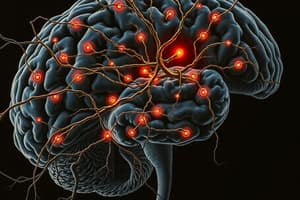Podcast
Questions and Answers
What is the primary function of the cerebrum within the brain?
What is the primary function of the cerebrum within the brain?
- Interpreting sensory information
- Overseeing emotions and reasoning (correct)
- Controlling balance and posture
- Processing motor responses
How many pairs of spinal nerves extend from the spinal cord?
How many pairs of spinal nerves extend from the spinal cord?
- 31 pairs (correct)
- 15 pairs
- 25 pairs
- 40 pairs
Which part of the nervous system is responsible for maintaining balance, posture, and coordination?
Which part of the nervous system is responsible for maintaining balance, posture, and coordination?
- Spinal cord (correct)
- Midbrain
- Cerebrospinal fluid
- Forebrain (cerebrum)
What is the primary function of the central nervous system?
What is the primary function of the central nervous system?
What is the primary function of sensory (afferent) neurons?
What is the primary function of sensory (afferent) neurons?
Which neurotransmitter plays a vital role in the regulation of mood and attention?
Which neurotransmitter plays a vital role in the regulation of mood and attention?
Which bodily functions does the CNS regulate?
Which bodily functions does the CNS regulate?
What is the primary role of interneurons in the CNS?
What is the primary role of interneurons in the CNS?
What is the primary function of motor (efferent) neurons?
What is the primary function of motor (efferent) neurons?
What role do neurotransmitters play in the central nervous system?
What role do neurotransmitters play in the central nervous system?
Flashcards are hidden until you start studying
Study Notes
Exploring the Central Nervous System: A Comprehensive Guide
The nervous system, a vital component of our body, is responsible for transmitting and processing information. In this article, we'll focus on the subtopic of the central nervous system (CNS), which includes the brain and spinal cord.
Structure of the Central Nervous System
The CNS serves as the primary control center for our body's functions. It comprises the brain and spinal cord, both enclosed in three layers of protective meninges and cushioned by cerebrospinal fluid (CSF).
- The brain: This complex organ is divided into several regions, each with specific functions. The three primary divisions are the forebrain (cerebrum), midbrain, and hindbrain. The cerebrum, the largest part of the brain, is responsible for higher cognitive functions such as thinking, reasoning, and emotions.
- The spinal cord: This long, cylindrical structure is responsible for transmitting information between the brain and the rest of the body, with 31 pairs of spinal nerves extending from it.
Functions of the Central Nervous System
The CNS is responsible for:
- Processing sensory information: The CNS receives and interprets information from our senses, such as sight, hearing, touch, taste, and smell.
- Coordinating motor responses: The CNS enables us to control our movements, maintaining balance, posture, and coordination.
- Regulating vital functions: The CNS controls essential bodily functions such as breathing, heart rate, digestion, and temperature regulation.
- Maintaining consciousness: The CNS sends signals to the brain to preserve wakefulness and arousal, enabling us to interact with our environment.
- Memory and learning: The CNS plays a crucial role in forming and retrieving memories, as well as learning new information and skills.
Neurons: The Building Blocks of the Central Nervous System
Neurons are specialized cells that transmit electrical signals between different parts of the nervous system. There are three primary types of neurons:
- Sensory (afferent) neurons: These neurons transmit information from sensory receptors to the CNS.
- Motor (efferent) neurons: These neurons transmit information from the CNS to muscles and glands.
- Interneurons: These neurons connect sensory and motor neurons, enabling the CNS to process and interpret information.
Neurotransmitters: The Chemical Messengers of the Central Nervous System
Neurotransmitters are chemical substances that facilitate communication between neurons. Some primary neurotransmitters include:
- Acetylcholine
- Norepinephrine
- Dopamine
- Serotonin
- Glutamate
- Gamma-aminobutyric acid (GABA)
These chemical messengers play vital roles in the regulation of mood, attention, learning, and motor function.
Conclusion
The central nervous system is a complex, intricate system that plays a critical role in our daily lives. Understanding the CNS can provide valuable insights into our physical and cognitive capabilities, as well as informing treatments for various neurological disorders. As we continue to learn more about this fascinating system, we can gain a deeper understanding of how our body functions and how we can optimize our health and wellbeing.
Studying That Suits You
Use AI to generate personalized quizzes and flashcards to suit your learning preferences.




